Green Preparation of S, N Co-Doped Low-Dimensional C Nanoribbon/C Dot Composites and Their Optoelectronic Response Properties in the Visible and NIR Regions
Abstract
1. Introduction
2. Materials and Methods
2.1. Materials
2.2. Preparation of Sodium Alginate Solution
2.3. Preparation of Graphene Oxide Nanoribbons
2.4. Preparation of Low-Dimensional Carbon/Carbon Nanocomposite Derived from Polymer
2.5. Characterization via SEM, TEM, UV-Vis-NIR, XRD, EDS, and Raman Spectra
2.6. Photocurrent Signal of Low-Dimensional Carbon/Carbon Nanocomposite in the Visible Light and NIR
2.7. Examination of the Tentacle Sensitivity of the Low-Dimensional C/C Nanocomposite to the Applied Force
3. Results and Discussion
4. Conclusions
Author Contributions
Funding
Institutional Review Board Statement
Informed Consent Statement
Data Availability Statement
Acknowledgments
Conflicts of Interest
References
- Wright, A.R.; Cao, J.C.; Zhang, C. Enhanced optical conductivity of bilayer graphene nanoribbons in the terahertz regime. Phys. Rev. Lett. 2009, 103, 207401. [Google Scholar]
- Tang, H.; Menabde, S.G.; Anwar, T.; Kim, J.; Jang, M.S.; Tagliabue, G. Photomodulated optical and electrical properties of graphene. Nanophotonics 2022, 11, 917–940. [Google Scholar]
- Li, H.; Li, X.; Park, J.H.; Tao, L.; Kim, K.K.; Lee, Y.H.; Xu, J.B. Restoring the photovoltaic effect in graphene-based van der Waals heterojunctions towards self powered high-detectivity photodetectors. Nano Energy 2019, 57, 214–221. [Google Scholar]
- Ogawa, S.; Shimatami, M.; Fukushima, S.; Okuda, S.; Kanai, Y.; Ono, T.; Matsumoto, K. Broadband photoresponse of graphene photodetector from visible to long-wavelength infrared wavelengths. Opt. Eng. 2019, 58, 57106–57112. [Google Scholar]
- Geng, H.; Yuan, D.; Yang, Z.; Tang, Z.; Zhang, X.; Yang, K.; Su, Y. Graphene van der Waals heterostructures for high-performance photodetectors. J. Mater. Chem. C Mater. 2019, 7, 11056–11067. [Google Scholar]
- Wang, J.; Mu, X.; Sun, M.; Mu, T. Optoelectronic properties and applications of graphene-based hybrid nanomaterials and van der Waals heterostructures. Appl. Mater. Today 2019, 16, 1–20. [Google Scholar]
- Yu, K.; Van Luan, N.; Kim, T.; Jeon, J.; Kim, J.; Moon, P.; Lee, Y.H.; Choi, E.J. Gate tunable optical absorption and band structure of twisted bilayer graphene. Phys. Rev. B 2019, 99, 241405–241411. [Google Scholar]
- Deng, T.; Zhang, Z.; Liu, Y.; Wang, Y.; Su, F.; Li, S.; Zhang, Y.; Li, H.; Chen, H.; Zhao, Z.; et al. Three-dimensional graphene field-effect transistors as high performance photodetectors. Nano Lett. 2019, 19, 1494–1503. [Google Scholar]
- Zhou, Q.; Shen, J.; Liu, X.; Li, Z.; Jiang, H.; Feng, S.; Feng, W.; Wang, Y.; Wei, D. Hybrid graphene heterojunction photodetector with high infrared responsivity through barrier tailoring. Nanotechnology 2019, 30, 195202–195209. [Google Scholar]
- Zheng, L.; Zhou, W.; Ning, Z.; Wang, G.; Cheng, X.; Hu, W.; Zhou, W.; Liu, Z.; Yang, S.; Xu, K.; et al. Ambipolar graphene–quantum dot phototransistors with CMOS compatibility. Adv. Opt. Mater. 2018, 6, 1800985–1800993. [Google Scholar]
- Grotevent, M.J.; Hail, C.U.; Yakunin, S.; Dirin, D.N.; Thodkar, K.; Barin, G.B.; Guyot-Sionnest, P.; Calame, M.; Poulikakos, D.; Kovalenko, M.V.; et al. Nanoprinted quantum dot–graphene photodetectors. Adv. Opt. Mater. 2019, 7, 1900019–1900026. [Google Scholar]
- Cao, Y.; Yang, H.; Zhao, Y.; Zhang, Y.; Ren, T.; Jin, B.; He, J.; Sun, J.L. Fully suspended reduced graphene oxide photodetector with annealing temperature-dependent broad spectral binary photoresponses. ACS Photonics 2017, 4, 2797–2806. [Google Scholar]
- Luo, C.; Xie, H.; Hou, C.; Zhang, Q.; Li, Y.; Wang, H. Flexible photodetector based on cotton coated with reduced graphene oxide and sulfur and nitrogen co-doped graphene quantum dots. J. Mater. Sci. 2019, 54, 3242–3251. [Google Scholar]
- Lundie, M.; Šljivančanin, Ž.; Tomić, S. Electronic and optical properties of reduced graphene oxide. J. Mater. Chem. C Mater. 2015, 3, 7632–7641. [Google Scholar]
- Yu, J.; Zhong, J.; Kuang, X.; Zeng, C.; Cao, L.; Liu, Y.; Liu, Z. Dynamic control of high range photoresponsivity in a graphene nanoribbon photodetector. Nanoscale Res. Lett. 2020, 15, 124–132. [Google Scholar]
- Prezzi, D.; Varsano, D.; Ruini, A.; Marini, A.; Molinari, E. Optical properties of graphene nanoribbons: The role of many-body effects. Phys. Rev. B Condens. Matter 2008, 77, 041404(R)–041407(R). [Google Scholar]
- He, M.; Dong, J.; Wang, H.; Xue, H.; Wu, Q.; Xin, B.; Gao, W.; He, X.; Yu, J.; Sun, H.; et al. Advance in close-edged graphene nanoribbon: Property investigation and structure fabrication. Small 2019, 15, 1804473–1804492. [Google Scholar]
- Soavi, G.; Conte, S.D.; Manzoni, C.; Viola, D.; Narita, A.; Hu, Y.; Feng, X.; Hohenester, U.; Molinari, E.; Prezzi, D.; et al. Exciton-exciton annihilation and biexciton stimulated emission in graphene nanoribbons. Nat. Commun. 2016, 7, 11010–11016. [Google Scholar]
- Denk, R.; Hohage, M.; Zeppenfeld, P.; Cai, J.; Pignedoli, C.A.; Söde, H.; Fasel, R.; Feng, X.; Müllen, K.; Wang, S.; et al. Exciton-dominated optical response of ultra-narrow graphene nanoribbons. Nat. Commun. 2014, 5, 4253–4259. [Google Scholar]
- Ostovari, F.; Moravvej-Farshi, M.K. Photodetectors with zigzag and armchair graphene nanoribbon channels and asymmetric source and drain contacts: Detectors for visible and solar blind applications. J. Appl. Phys. 2016, 120, 144505–144511. [Google Scholar]
- Alavi, S.K.; Senkovskiy, B.V.; Hertel, D.; Haberer, D.; Ando, Y.; Meerholz, K.; Fischer, F.R.; Grüneis, A.; Lindfors, K. Photodetection using atomically precise graphene nanoribbons. ACS Appl. Nano Mater. 2020, 3, 8343–8351. [Google Scholar]
- Rudi, S.G.; Soleimani-Amiri, S. Bilayer armchair graphene nanoribbon photodetector with Stone-Wales defect: A computational study. Mater. Sci. Semicond. Process. 2022, 150, 106918–106928. [Google Scholar]
- Candini, A.; Martini, L.; Chen, Z.; Mishra, N.; Convertino, D.; Coletti, C.; Narita, A.; Feng, X.; Müllen, K.; Affronte, M. High photoresponsivity in graphene nanoribbon field-effect transistor devices contacted with graphene electrodes. J. Phys. Chem. C 2017, 121, 10620–10625. [Google Scholar]
- Liu, G.; Wu, Y.; Lin, Y.M.; Farmer, D.B.; Ott, J.A.; Bruley, J.; Grill, A.; Avouris, P.; Pfeiffer, D.; Balandin, A.A.; et al. Epitaxial graphene nanoribbon array fabrication using BCP-assisted nanolithography. ACS Nano 2012, 6, 6786–6792. [Google Scholar]
- Kosynkin, D.V.; Higginbotham, A.L.; Sinitskii, A.; Lomeda, J.R.; Dimiev, A.; Price, B.K.; Tour, J.M. Longitudinal unzipping of carbon nanotubes to form graphene nanoribbons. Nature 2009, 458, 872–876. [Google Scholar]
- Jiao, L.Y.; Zhang, L.; Wang, X.R.; Diankov, G.; Dai, H.J. Narrow graphene nanoribbons from carbon nanotubes. Nature 2009, 458, 877–880. [Google Scholar]
- Dutta, S.; Pati, S.K. Novel properties of graphene nanoribbons: A review. J. Mater. Chem. 2010, 20, 8207–8223. [Google Scholar]
- Wang, H.; Wang, H.S.; Ma, C.; Chen, L.; Jiang, C.; Chen, C.; Xie, X.; Li, A.P.; Wang, X. Graphene nanoribbons for quantum electronics. Nat. Rev. Phys. 2021, 3, 791–802. [Google Scholar]
- Son, Y.W.; Cohen, M.L.; Louie, S.G. Energy Gaps in Graphene Nanoribbons. Phys. Rev. Lett. 2006, 97, 216803. [Google Scholar] [PubMed]
- Raza, H.; Kan, E.C. Armchair graphene nanoribbons: Electronic structure and electric-field modulation. Phys. Rev. B 2008, 77, 245434. [Google Scholar]
- Ostovari, F.; Moravvej-Farshi, M.K. Photodetectors with armchair graphene nanoribbons and asymmetric source and drain contacts. Appl. Surf. Sci. 2014, 318, 108–112. [Google Scholar]
- Zarei, M.; Sharifi, M. Defect-based graphene nanoribbon photodetectors: A numerical study. J. Appl. Phys. 2016, 119, 213104. [Google Scholar]
- Zhong, X.; Pandey, R.; Karna, S.P. Stacking dependent electronic structure and transport in bilayer graphene nanoribbons. Carbon 2012, 50, 784–790. [Google Scholar]
- Xu, J.Y.; Yu, J.S.; Liao, J.H.; Yang, X.B.; Wu, C.Y.; Wang, Y.; Wang, L.; Xie, C.; Luo, L.B. Opening the band gap of graphene via fluorination for high-performance dual mode photodetector application. ACS Appl. Mater. Interfaces 2019, 11, 21702–21710. [Google Scholar] [PubMed]
- Park, K.H.; Song, S.H. Graphene quantum dots with blue and yellow luminescence fabricated by modulating intercalation state. Materials 2022, 15, 6567. [Google Scholar] [CrossRef] [PubMed]
- Pierrat, P.; Gaumet, J.-J. Graphene quantum dots: Emerging organic materials with remarkable and tunable luminescence features. Tetrahedron Lett. 2020, 61, 152554–152560. [Google Scholar]
- Haider, G.; Roy, P.; Chiang, C.W.; Tan, W.C.; Liou, Y.R.; Chang, H.T.; Liang, C.T.; Shih, W.H.; Chen, Y.F. Electrical-polarization-induced ultrahigh responsivity photodetectors based on graphene and graphene quantum dots. Adv. Funct. Mater. 2016, 26, 620–628. [Google Scholar]
- Tetsuka, H.; Nagoya, A.; Fukusumi, T.; Matsui, T. Molecularly designed, nitrogen functionalized graphene quantum dots for optoelectronic devices. Adv. Mater. 2016, 28, 4632–4638. [Google Scholar] [PubMed]
- Tang, L.; Ji, R.; Cao, X.; Lin, J.; Jiang, H.; Li, X.; Teng, K.S.; Luk, C.M.; Zeng, S.; Hao, J.; et al. Deep ultraviolet photoluminescence of water-soluble self-passivated graphene quantum dots. ACS Nano 2012, 6, 5102–5110. [Google Scholar]
- Chiang, C.W.; Haider, G.; Tan, W.C.; Liou, Y.R.; Lai, Y.C.; Ravindranath, R.; Chang, H.T.; Chen, Y.F. Highly stretchable and sensitive photodetectors based on hybrid graphene and graphene quantum dots. ACS Appl. Mater. Interfaces 2016, 8, 466–471. [Google Scholar]
- Zhang, Q.; Jie, J.; Diao, S.; Shao, Z.; Zhang, Q.; Wang, L.; Deng, W.; Hu, W.; Xia, H.; Yuan, X.; et al. Solution-processed graphene quantum dot deep-UV photodetectors. ACS Nano 2015, 9, 1561–1570. [Google Scholar]
- Tang, L.; Ji, R.; Li, X.; Bai, G.; Liu, C.P.; Hao, J.; Lin, J.; Jiang, H.; Teng, K.S.; Yang, Z.; et al. Deep ultraviolet to near-infrared emission and photoresponse in layered n-doped graphene quantum dots. ACS Nano 2014, 8, 6312–6320. [Google Scholar]
- Sarkar, K.; Devi, P.; Lata, A.; Ghosh, R.; Kumar, P. Engineering carbon quantum dots for enhancing the broadband photoresponse in a silicon process-line compatible photodetector. J. Mater. Chem. C Mater. 2019, 7, 13182–13191. [Google Scholar]
- Huang, H.; Wang, F.; Liu, Y.; Wang, S.; Peng, L.M. Plasmonic enhanced performance of an infrared detector based on carbon nanotube films. ACS Appl. Mater. Interfaces 2017, 9, 12743–12749. [Google Scholar] [PubMed]
- An, Y.; Rao, H.; Bosman, G.; Ural, A. Characterization of carbon nanotube film silicon Schottky barrier photodetectors. J. Vac. Sci. Technol. 2012, 30, 21805–21810. [Google Scholar]
- Nanot, S.; Ha, E.H.; Kim, J.H.; Hauge, R.H.; Kono, J. Optoelectronic properties of single-wall carbon nanotubes. Adv. Mater. 2012, 24, 4977–4994. [Google Scholar]
- Avouris, P.; Chen, Z.; Perebeinos, V. Carbon-based electronics. Nat. Nanotechnol. 2007, 2, 605–615. [Google Scholar] [PubMed]
- Shiraki, T.; Miyauchi, Y.; Matsuda, K.; Nakashima, N. Carbon nanotube photoluminescence modulation by local chemical and supramolecular chemical functionalization. Acc. Chem. Res. 2020, 53, 1846–1859. [Google Scholar]
- Liu, Y.; Yin, J.; Wang, P.; Hu, Q.; Wang, Y.; Xie, Y.; Zhao, Z.; Dong, Z.; Zhu, J.L.; Chu, W.; et al. High-performance, ultra-broadband, ultraviolet to terahertz photodetectors based on suspended carbon nanotube films. ACS Appl. Mater. Interfaces 2018, 10, 36304–36311. [Google Scholar]
- Zhang, M.; Ban, D.; Xu, C.; Yeow, J.T.W. Large-area and broadband thermoelectric infrared detection in a carbon nanotube black-body absorber. ACS Nano 2019, 13, 13285–13292. [Google Scholar]
- Bergemann, K.; Léonard, F. Room-temperature phototransistor with negative photoresponsivity of 108 A W−1 using fullerene-sensitized aligned carbon nanotubes. Small 2018, 14, 1802806–1802813. [Google Scholar]
- Qin, S.; Chen, X.; Du, Q.; Nie, Z.; Wang, X.; Lu, H.; Wang, X.; Liu, K.; Xu, Y.; Shi, Y.; et al. Sensitive and robust ultraviolet photodetector array based on self-assembled graphene/C60 hybrid films. ACS Appl. Mater. Interfaces 2018, 10, 38326–38333. [Google Scholar] [PubMed]
- Pyo, S.; Kim, W.; Jung, H.I.; Choi, J.; Kim, J. Heterogeneous integration of carbon nanotube–graphene for high-performance, flexible, and transparent photodetectors. Small 2017, 13, 1700918–1700928. [Google Scholar]
- Cai, B.; Su, Y.; Tao, Z.; Hu, J.; Zou, C.; Yang, Z.; Zhang, Y. Highly sensitive broadband single-walled carbon nanotube photodetectors enhanced by separated graphene nanosheets. Adv. Opt. Mater. 2018, 6, 1800791–1800798. [Google Scholar]
- Lee, E.J.H.; Zhi, L.; Burghard, M.; Mullen, K.; Kern, K. Electrical properties and photoconductivity of stacked-graphene carbon nanotubes. Adv. Mater. 2010, 22, 1854–1857. [Google Scholar] [PubMed]
- Cao, J.; Zou, Y.; Gong, X.; Gou, P.; Qian, J.; Qian, R.; An, Z. Double-layer heterostructure of graphene/carbon nanotube films for highly efficient broadband photodetector. Appl. Phys. Lett. 2018, 113, 61112–61118. [Google Scholar]
- Zhang, Y.; Deng, T.; Li, S.; Sun, J.; Yin, W.; Fang, Y.; Liu, Z. Highly sensitive ultraviolet photodetectors based on single wall carbon nanotube-graphene hybrid films. Appl. Surf. Sci. 2020, 512, 145651–145658. [Google Scholar]
- Liu, Y.; Wang, F.; Wang, X.; Wang, X.; Flahaut, E.; Liu, X.; Li, Y.; Wang, X.; Xu, Y.; Shi, Y.; et al. Planar carbon nanotube-graphene hybrid films for high-performance broadband photodetectors. Nat. Commun. 2015, 6, 8589–8596. [Google Scholar]
- Liu, Y.; Liu, Y.; Qin, S.; Xu, Y.; Zhang, R.; Wang, F. Graphene-carbon nanotube hybrid films for high-performance flexible photodetectors. Nano Res. 2017, 10, 1880–1887. [Google Scholar]
- Lu, R.; Christianson, C.; Weintrub, B.; Wu, J.Z. High photoresponse in hybrid graphene-carbon nanotube infrared detectors. ACS Appl. Mater. Interfaces 2013, 5, 11703–11707. [Google Scholar]
- Xu, W.L.; Ding, C.; Niu, M.S.; Yang, X.Y.; Zheng, F.; Xiao, J.; Zheng, M.; Hao, X.T. Reduced graphene oxide assisted charge separation and serving as transport pathways in planar perovskite photodetector. Org. Electron. 2020, 81, 105663–105668. [Google Scholar]
- Xu, W.; Guo, Y.; Zhang, X.; Zheng, L.; Zhu, T.; Zhao, D.; Hu, W.; Gong, X. Room temperature-operated ultrasensitive broadband photodetectors by perovskite incorporated with conjugated polymer and single-wall carbon nanotubes. Adv. Funct. Mater. 2018, 28, 1705541–1705551. [Google Scholar]
- Surendran, A.; Yu, X.; Begum, R.; Tao, Y.; Wang, Q.J.; Leong, W.L. All inorganic mixed halide perovskite nanocrystal-graphene hybrid photodetector: From ultrahigh gain to photostability. ACS Appl. Mater. Interfaces 2019, 11, 27064–27072. [Google Scholar]
- Chen, Z.; Kang, Z.; Rao, C.; Cheng, Y.; Liu, N.; Zhang, Z.; Li, L.; Gao, Y. Improving performance of hybrid graphene–perovskite photodetector by a scratch channel. Adv. Electron. Mater. 2019, 5, 1900168–1900175. [Google Scholar]
- Xia, K.; Wu, W.; Zhu, M.; Shen, X.; Yin, Z.; Wang, H.; Li, S.; Zhang, M.; Wang, H.; Lu, H.; et al. CVD growth of perovskite/graphene films for high performance flexible image sensor. Sci. Bull. 2020, 65, 343–349. [Google Scholar]
- Bera, K.P.; Haider, G.; Huang, Y.T.; Roy, P.K.; Inbaraj, C.R.P.; Liao, Y.M.; Lin, H.I.; Lu, C.H.; Shen, C.; Shih, W.Y.; et al. Graphene sandwich stable perovskite quantum-dot light-emissive ultrasensitive and ultrafast broadband vertical phototransistors. ACS Nano 2019, 13, 12540–12552. [Google Scholar]
- Ding, J.; Fang, H.; Lian, Z.; Lv, Q.; Sun, J.L.; Yan, Q. High-performance stretchable photodetector based on CH3NH3PbI3 microwires and graphene. Nanoscale 2018, 10, 10538–10544. [Google Scholar]
- Li, K.; Zhu, Y.; Zhang, Y.; Zhang, D.; Zhou, J.; Li, X.; Ruan, S. Built-in electric field promotes photoexcitation separation and depletion of most carriers in TiO2:C UV detectors. Nanotechnology 2019, 30, 295502–295509. [Google Scholar]
- Li, S.; Yin, W.; Li, Y.; Sun, J.; Zhu, M.; Liu, Z.; Deng, T. High sensitivity ultraviolet detection based on three-dimensional graphene field effect transistors decorated with TiO2 NPs. Nanoscale 2019, 11, 14912–14920. [Google Scholar] [PubMed]
- Sahatiya, P.; Shinde, A.; Badhulika, S. Pyro-phototronic nanogenerator based on flexible 2D ZnO/graphene heterojunction and its application in self-powered near infrared photodetector and active analog frequency modulation. Nanotechnology 2018, 29, 325205–325214. [Google Scholar] [PubMed]
- Ko, K.B.; Ryu, B.D.; Han, M.; Hong, C.H.; Dinh, D.A.; Cuong, T.V. Multidimensional graphene and ZnO-based heterostructure for flexible transparent ultraviolet photodetector. Appl. Surf. Sci. 2019, 481, 524–530. [Google Scholar]
- Cook, B.; Gong, M.; Corbin, A.; Ewing, D.; Tramble, A.; Wu, J. Inkjet-printed imbedded graphene nanoplatelet/zinc oxide bulk heterojunctions nanocomposite films for ultraviolet photodetection. ACS Omega 2019, 4, 22497–22503. [Google Scholar] [PubMed]
- Ju, D.; Liu, X.; Zhu, Z.; Wang, S.; Liu, S.; Gu, Y.; Chang, J.; Liu, Q.; Zou, Y. Solution processed membrane-based wearable ZnO/graphene Schottky UV photodetectors with imaging application. Nanotechnology 2019, 30, 375701–375709. [Google Scholar]
- Liu, H.; Gao, F.; Hu, Y.; Zhang, J.; Wang, L.; Feng, W.; Hou, J.; Hu, P. Enhanced photoresponse of monolayer MoS2 through hybridization with carbon quantum dots as efficient photosensitizer. 2D Mater. 2019, 6, 35025–35032. [Google Scholar]
- Sahatiya, P.; Jones, S.S.; Badhulika, S. 2D MoS2–carbon quantum dot hybrid based large area, flexible UV–vis–NIR photodetector on paper substrate. Appl. Mater. Today 2018, 10, 106–114. [Google Scholar]
- Nguyen, D.A.; Oh, H.M.; Duong, N.T.; Bang, S.; Yoon, S.J.; Jeong, M.S. Highly enhanced photoresponsivity of a monolayer WSe2 photodetector with nitrogen doped graphene quantum dots. ACS Appl. Mater. Interfaces 2018, 10, 10322–10329. [Google Scholar] [PubMed]
- Ghasemi, F.; Abdollahi, A.; Abnavi, A.; Mohajerzadeh, S.; Abdi, Y. Ultrahigh sensitive MoS2/rGo photodetector based on aligned CNT contacts. IEEE Electron. Device Lett. 2018, 39, 1465–1468. [Google Scholar]
- Yu, X.X.; Yin, H.; Li, H.X.; Zhao, H.; Li, C.; Zhu, M.Q. A novel high-performance self powered UV-vis-NIR photodetector based on a CdS nanorod array/reduced graphene oxide film heterojunction and its piezo-phototronic regulation. J. Mater. Chem. C Mater. 2018, 6, 630–636. [Google Scholar]
- Liu, B.; Zhao, C.; Chen, X.; Zhang, L.; Li, Y.; Yan, H.; Zhang, Y. Self-powered and fast photodetector based on graphene/MoSe2/Au heterojunction. Superlattice. Microst. 2019, 130, 87–92. [Google Scholar]
- Kang, B.; Kim, Y.; Yoo, W.J.; Lee, C. Ultrahigh photoresponsive device based on ReS2/graphene heterostructure. Small 2018, 14, 1802593. [Google Scholar]
- Alamri, M.; Gong, M.; Cook, B.; Goul, R.; Wu, J.Z. Plasmonic WS2 nanodiscs/graphene van der Waals heterostructure photodetectors. ACS Appl. Mater. Interfaces 2019, 11, 33390–33398. [Google Scholar]
- Singh, V.K.; Yadav, S.M.; Mishra, H.; Kumar, R.; Tiwari, R.S.; Pandey, A.; Srivastava, A. WS2 quantum dot graphene nanocomposite film for UV photodetection. ACS Appl. Nano Mater. 2019, 2, 3934–3942. [Google Scholar]
- Lv, Q.; Yan, F.; Wei, X.; Wang, K. High-performance, self-driven photodetector based on graphene sandwiched GaSe/WS2 heterojunction. Adv. Opt. Mater. 2018, 6, 1700490–1700496. [Google Scholar]
- Rossi, A.; Spirito, D.; Bianco, F.; Forti, S.; Fabbri, F.; Büch, H.; Tredicucci, A.; Krahne, R.; Coletti, C. Patterned tungsten disulfide/graphene heterostructures for efficient multifunctional optoelectronic devices. Nanoscale 2018, 10, 4332–4338. [Google Scholar]
- Wang, Z.; Zeng, P.; Hu, S.; Wu, X.; He, J.; Wu, Z.; Wang, W.; Zheng, P.; Zheng, H.; Zheng, L.; et al. Broadband photodetector based on ReS2/graphene/WSe2 heterostructure. Nanotechnology 2021, 32, 465201. [Google Scholar]
- Li, A.; Chen, Q.; Wang, P.; Gan, Y.; Qi, T.; Wang, P.; Tang, F.; Wu, J.Z.; Chen, R.; Zhang, L.; et al. Ultrahigh-sensitive broadband photodetectors based on dielectric shielded MoTe2/graphene/SnS2 p–g–n junctions. Adv. Mater. 2019, 31, 1805656. [Google Scholar]
- Yu, J.-Q.; Ke, S.-S.; Lü, H.-F. Electronic properties and tunable Schottky barrier of non-Janus MoSSe/graphene heterostructures. J. Phys. D Appl. Phys. 2022, 55, 035104. [Google Scholar]
- Liu, Y.; Shivananju, B.N.; Wang, Y.; Zhang, Y.; Yu, W.; Xiao, S.; Sun, T.; Ma, W.; Mu, H.; Lin, S.; et al. Highly efficient and air-stable infrared photodetector based on 2D layered graphene-black phosphorus heterostructure. ACS Appl. Mater. Interfaces 2017, 9, 36137–36145. [Google Scholar]
- Xu, J.; Song, Y.J.; Park, J.H.; Lee, S. Graphene/black phosphorus heterostructured photodetector. Solid State Electron. 2018, 144, 86–89. [Google Scholar]
- Huang, P.; Riccardi, E.; Messelot, S.; Graef, H.; Valmorra, F.; Tignon, J.; Taniguchi, T.; Watanabe, K.; Dhillon, S.; Plaçais, B.; et al. Ultra-long carrier lifetime in neutral graphene-h-BN van der Waals heterostructures under mid infrared illumination. Nat. Commun. 2020, 11, 863–872. [Google Scholar] [PubMed]
- Yu, H.; Joo, P.; Lee, D.; Kim, B.S.; Oh, J.H. Photoinduced charge-carrier dynamics of phototransistors based on perylene diimide/reduced graphene oxide core/shell p-n junction nanowires. Adv. Opt. Mater. 2015, 3, 241–247. [Google Scholar]
- Bera, K.P.; Haider, G.; Usman, M.; Roy, P.K.; Lin, H.I.; Liao, Y.M.; Inbaraj, C.R.P.; Liou, Y.R.; Kataria, M.; Lu, K.L.; et al. Trapped photons induced ultrahigh external quantum efficiency and photoresponsivity in hybrid graphene/metal organic framework broadband wearable photodetectors. Adv. Funct. Mater. 2018, 28, 1804802–1804815. [Google Scholar]
- Che, Y.; Zhang, G.; Zhang, Y.; Cao, X.; Cao, M.; Yu, Y.; Dai, H.; Yao, J. Solution processed graphene phototransistor functionalized with P3HT/graphene bulk heterojunction. Opt. Commun. 2018, 425, 161–165. [Google Scholar]
- Xie, C.; Yan, F. Perovskite/poly(3-hexylthiophene)/graphene multiheterojunction phototransistors with ultrahigh gain in broadband wavelength region. ACS Appl. Mater. Interfaces 2017, 9, 1569–1576. [Google Scholar] [PubMed]
- Han, J.; Wang, J.; Yang, M.; Kong, X.; Chen, X.; Huang, Z.; Guo, H.; Gou, J.; Tao, S.; Liu, Z.; et al. Graphene/organic semiconductor heterojunction phototransistors with broadband and Bi-directional photoresponse. Adv. Mater. 2018, 30, 1804020–1804028. [Google Scholar]
- Gong, Y.; Adhikari, P.; Liu, Q.; Wang, T.; Gong, M.; Chan, W.L.; Ching, W.Y.; Wu, J. Designing the interface of carbon nanotube/biomaterials for high-performance ultra-broadband photodetection. ACS Appl. Mater. Interfaces 2017, 9, 11016–11024. [Google Scholar] [PubMed]
- Pelella, A.; Grillo, A.; Faella, E.; Luongo, G.; Askari, M.B.; Di Bartolomeo, A. Graphene-Silicon device for visible and infrared photodetection. ACS Appl. Mater. Interfaces 2021, 13, 47895–47903. [Google Scholar] [PubMed]
- Ji, P.; Yang, S.; Wang, Y.; Li, K.; Wang, Y.; Suo, H.; Woldu, Y.T.; Wang, X.; Wang, F.; Zhang, L.; et al. High-performance photodetector based on an interface engineering-assisted graphene/silicon Schottky junction. Microsyst. Nanoeng. 2022, 8, 9–17. [Google Scholar] [PubMed]
- Sarkar, K.; Devi, P.; Lata, A.; Lokku, V.K.; Kumar, P. Surface engineered hybrid core–shell Si-nanowires for efficient and stable broadband photodetectors. Adv. Opt. Mater. 2020, 8, 2000228–2000237. [Google Scholar]
- Liu, X.; Zhou, Q.; Luo, S.; Du, H.; Cao, Z.; Peng, X.; Feng, W.; Shen, J.; Wei, D. Infrared photodetector based on the photothermionic effect of graphene-nanowall/silicon heterojunction. ACS Appl. Mater. Interfaces. 2019, 11, 17663–17669. [Google Scholar]
- Chang, K.E.; Yoo, T.J.; Kim, C.; Kim, Y.J.; Lee, S.K.; Kim, S.Y.; Heo, S.; Kwon, M.G.; Lee, B.H. Gate-controlled graphene–silicon Schottky junction photodetector. Small 2018, 14, 1801182–1801189. [Google Scholar]
- Li, L.; Dong, Y.; Guo, W.; Qian, F.; Xiong, F.; Fu, Y.; Du, Z.; Xu, C.; Sun, J. High responsivity photodetectors made of graphene nanowalls grown on Si. Appl. Phys. Lett. 2019, 115, 81101–81106. [Google Scholar]
- Casalino, M.; Russo, R.; Russo, C.; Ciajolo, A.; Di Gennaro, E.; Iodice, M.; Coppola, G. Free-space Schottky graphene/silicon photodetectors operating at 2 μm. ACS Photonics 2018, 5, 4577–4585. [Google Scholar]
- Hu, M.; Yan, Y.; Huang, K.; Khan, A.; Qiu, X.; Xu, D.; Zhang, H.; Yu, X.; Yang, D. Performance improvement of graphene/silicon photodetectors using high work function metal nanoparticles with plasma effect. Adv. Opt. Mater. 2018, 6, 1701243–1701250. [Google Scholar]
- Selvi, H.; Unsuree, N.; Whittaker, E.; Halsall, M.P.; Hill, E.W.; Thomas, A.; Parkinson, P.; Echtermeyer, T.J. Towards substrate engineering of graphene silicon Schottky diode photodetectors. Nanoscale 2018, 10, 3399–3409. [Google Scholar]
- Wang, P.F.; Liu, Y.; Yin, J.; Ma, W.; Dong, Z.; Zhang, W.; Zhu, J.L.; Sun, J.L. A tunable positive and negative photoconductive photodetector based on a gold/graphene/p-type silicon heterojunction. J. Mater. Chem. C Mater. 2019, 7, 887–896. [Google Scholar]
- Tian, H.; Hu, A.; Liu, Q.; He, X.; Guo, X. Interface-induced high responsivity in hybrid graphene/GaAs photodetector. Adv. Opt. Mater. 2020, 8, 1901741–1901748. [Google Scholar]
- Wu, J.; Yang, Z.; Qiu, C.; Zhang, Y.; Wu, Z.; Yang, J.; Lu, Y.; Li, J.; Yang, D.; Hao, R.; et al. Enhanced performance of a graphene/GaAs self-driven nearinfrared photodetector with upconversion nanoparticles. Nanoscale 2018, 10, 8023–8030. [Google Scholar] [PubMed]
- Hu, A.; Tian, H.; Liu, Q.; Wang, L.; Wang, L.; He, X.; Luo, Y.; Guo, X. Graphene on self assembled InGaN quantum dots enabling ultrahighly sensitive photodetectors. Adv. Opt. Mater. 2019, 7, 1801792–1801798. [Google Scholar]
- Tao, Z.; Zhou, D.; Yin, H.; Cai, B.; Huo, T.; Ma, J.; Di, Z.; Hu, N.; Yang, Z.; Su, Y. Graphene/GaAs heterojunction for highly sensitive, self-powered Visible/NIR photodetectors. Mater. Sci. Semicond. Process. 2020, 111, 104989–104994. [Google Scholar]
- Lu, Y.; Feng, S.; Wu, Z.; Gao, Y.; Yang, J.; Zhang, Y.; Hao, Z.; Li, J.; Li, E.; Chen, H.; et al. Broadband surface plasmon resonance enhanced self-powered graphene/GaAs photodetector with ultrahigh detectivity. Nano Energy 2018, 47, 140–149. [Google Scholar]
- Cao, G.; Wang, F.; Peng, M.; Shao, X.; Yang, B.; Hu, W.; Li, X.; Chen, J.; Shan, Y.; Wu, P.; et al. Multicolor broadband and fast photodetector based on InGaAs–insulator–graphene hybrid heterostructure. Adv. Electron. Mater. 2020, 6, 1901007–1901014. [Google Scholar]
- Journot, T.; Bouchiat, V.; Gayral, B.; Dijon, J.; Hyot, B. Self-assembled UV photodetector made by direct epitaxial GaN growth on graphene. ACS Appl. Mater. Interfaces 2018, 10, 18857–18862. [Google Scholar]
- Wu, J.; Qiu, C.; Feng, S.; Yao, T.; Yan, Y.; Lin, S. A synergetic enhancement of localized surface plasmon resonance and photo-induced effect for graphene/GaAs photodetector. Nanotechnology 2020, 31, 105204–105210. [Google Scholar]
- Yang, Q.; Wu, Q.; Luo, W.; Yao, W.; Yan, S.; Shen, J. InGaAs/graphene infrared photodetectors with enhanced responsivity. Mater. Res. Express 2019, 6, 116208–116217. [Google Scholar]
- Li, J.; Zhao, F.; Nan, F.; Wang, J.; Zhang, Y.; Liang, K.; Xue, X.; Chen, T.; Kong, L.; Ge, J.; et al. Polythiophene Derivatives Carbonized Polymer Dots: Aggregation Induced Solid-State Fluorescence Emission. Chin. J. Chem. 2023, 41, 1950–1956. [Google Scholar]
- Xue, S.; Li, P.; Sun, L.; An, L.; Qu, D.; Wang, X.; Sun, Z. The Formation Process and Mechanism of Carbon Dots Prepared from Aromatic Compounds as Precursors: A Review. Small 2023, 19, 2206180. [Google Scholar]
- Yang, S.; Zhang, Y.; Xue, Y.; Lu, S.; Yang, H.; Yang, L.; Ding, C.; Yu, S. Cross-Linked Polyamide Chains Enhanced the Fluorescence of Polymer Carbon Dots. ACS Omega 2020, 5, 8219–8229. [Google Scholar]
- Ma, X.; Gao, M.; Zhang, X.; Wang, Y.; Li, G. Polymer-Derived Carbon Nanofiber and Its Photocurrent-Switching Responses of Carbon Nanofiber/Cu Nanocomposite in Wide Ranges of Excited Light Wavelength. Polymers 2023, 15, 3528. [Google Scholar] [CrossRef] [PubMed]
- Ma, X.; Gao, M.; Zhang, X.; Wang, Y.; Li, G. Interface Interaction between MoO3 and Carbon Dots Derived from Chitosan Promoted the Photocurrent Extraction Ability of Carriers in a Wide Range of the Light Spectrum. Coatings 2024, 14, 171. [Google Scholar] [CrossRef]
- Ma, X.; Zhang, X.; Gao, M.; Wang, Y.; Li, G. Polymer-Gel-Derived PbS/C Composite Nanosheets and Their Photoelectronic Response Properties Studies in the NIR. Coatings 2024, 14, 981. [Google Scholar] [CrossRef]
- Zhang, B.; Zheng, J.; Ma, L.; Guo, B.; He, X.; Gao, M.; Bian, L.; Ma, X.; Li, G. Charge Behavior of Low-Dimensional V2O5/Graphene Nanoribbons Oxides Nanocomposites under Irradiation of Visible Light and its Application. Mater. Sci. Forum 2016, 847, 203–210. [Google Scholar]
- Zhang, B.; He, X.; Gao, M.; Ma, X.; Li, G. Entanglement of CeO2 Nanorods and Graphene Nanoribbons and their Properties Studies of Nanocomposites. Mater. Sci. Forum 2015, 814, 153–160. [Google Scholar]
- Ma, X.; Li, C.; Gao, M.; Zhang, X.; Wang, Y.; Li, G. Interface Optimization of Metal Quantum Dots/Polymer Nanocomposites and their Properties: Studies of Multi-Functional Organic/Inorganic Hybrid. Materials 2023, 16, 150. [Google Scholar]

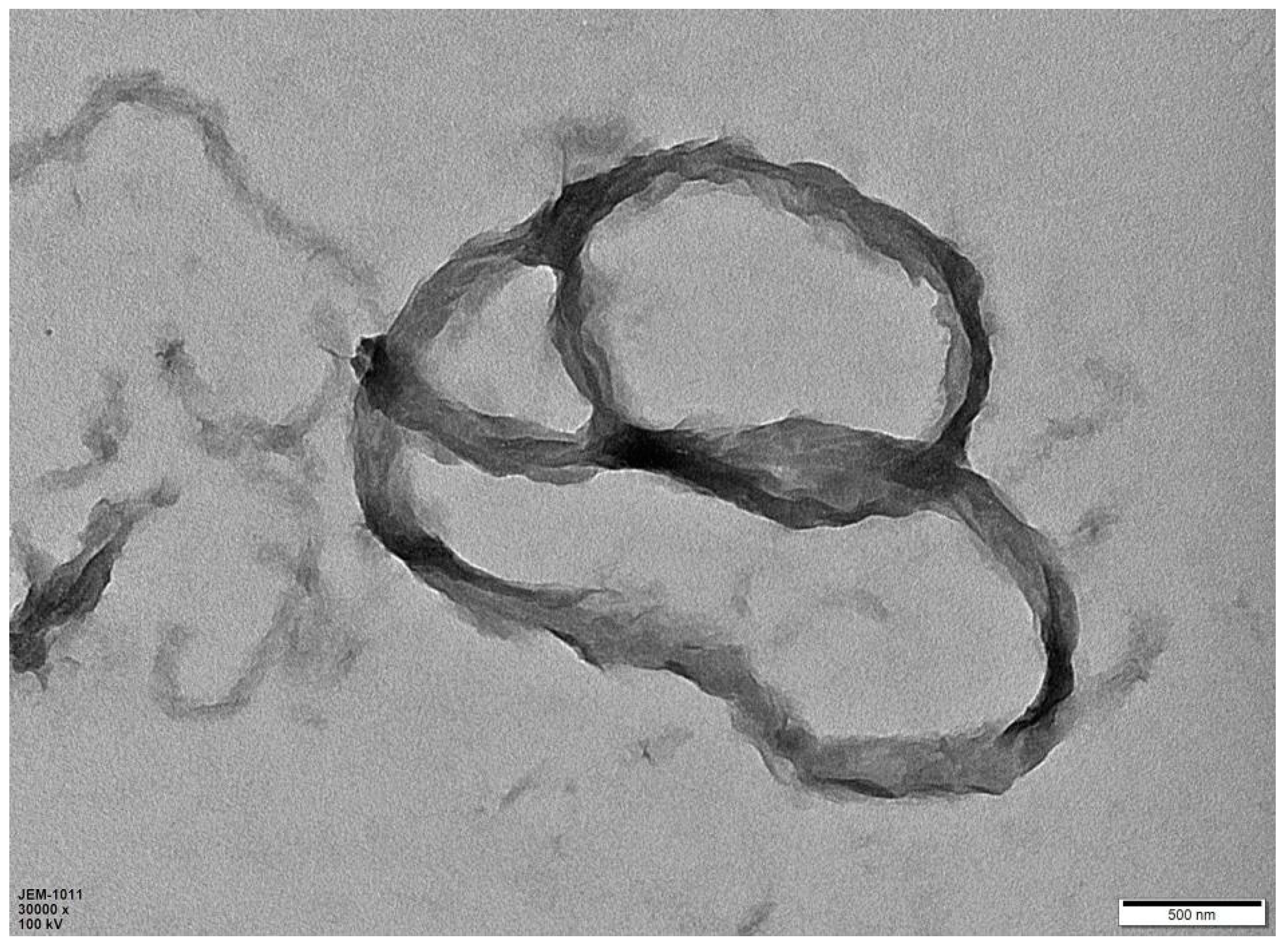
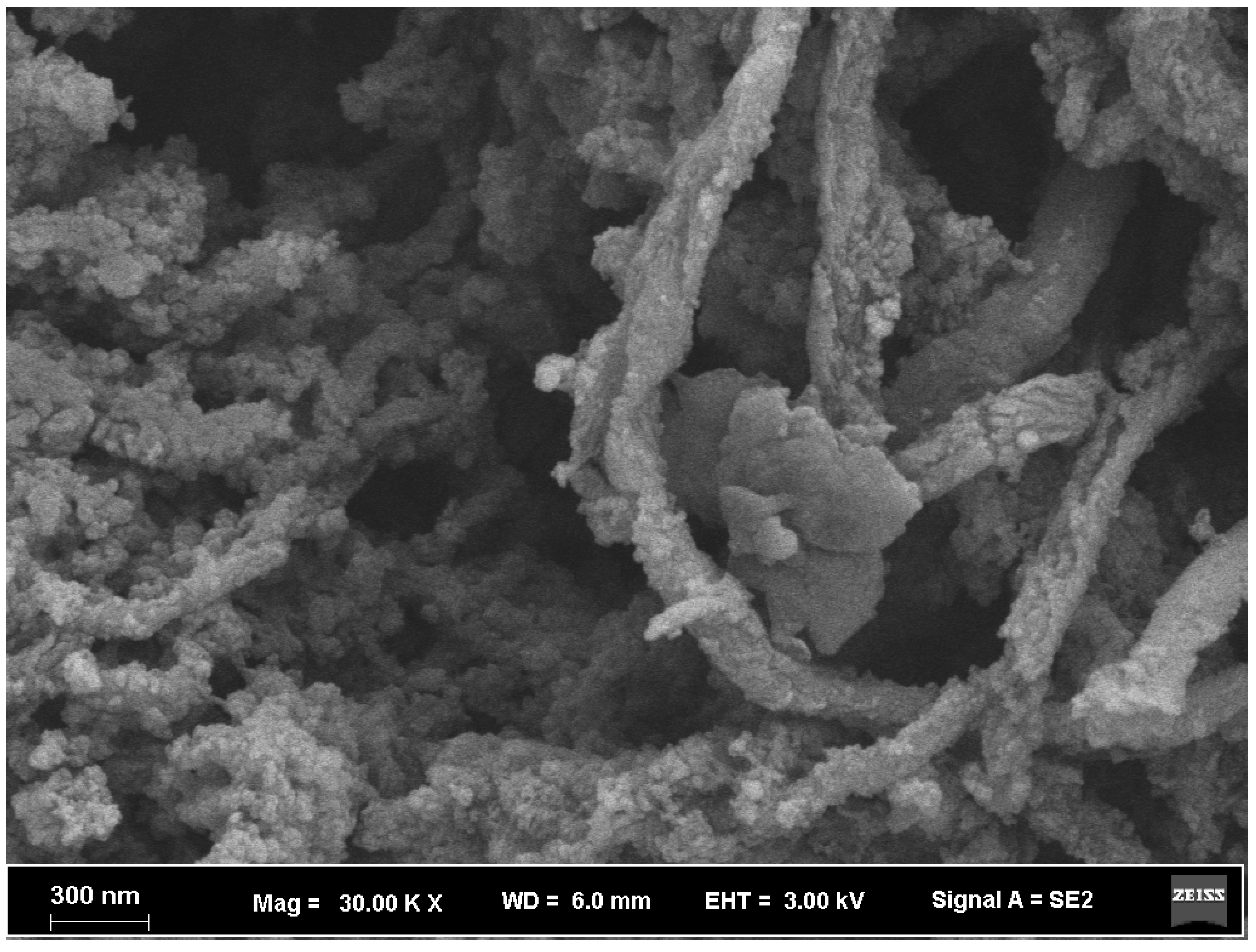
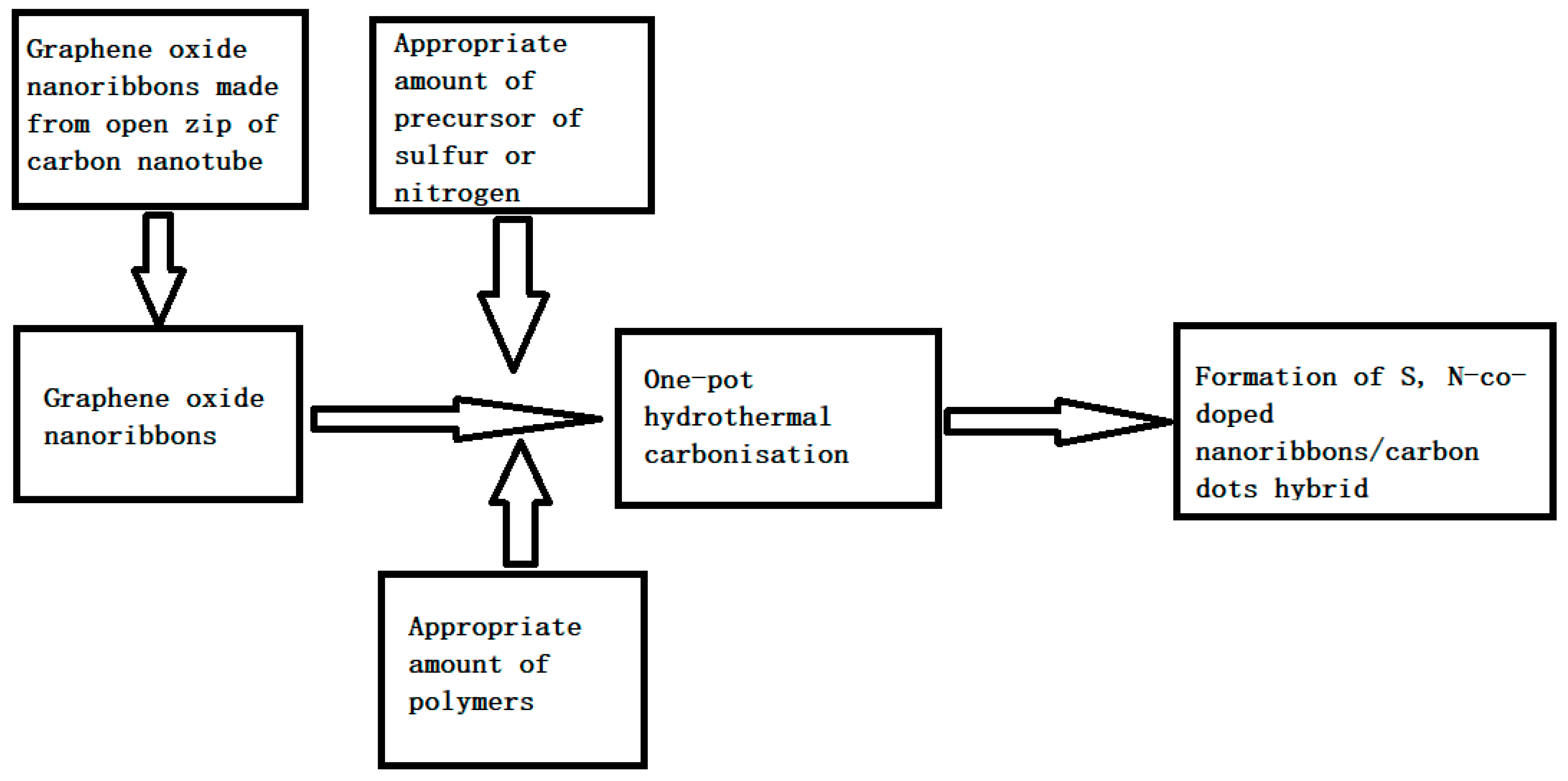
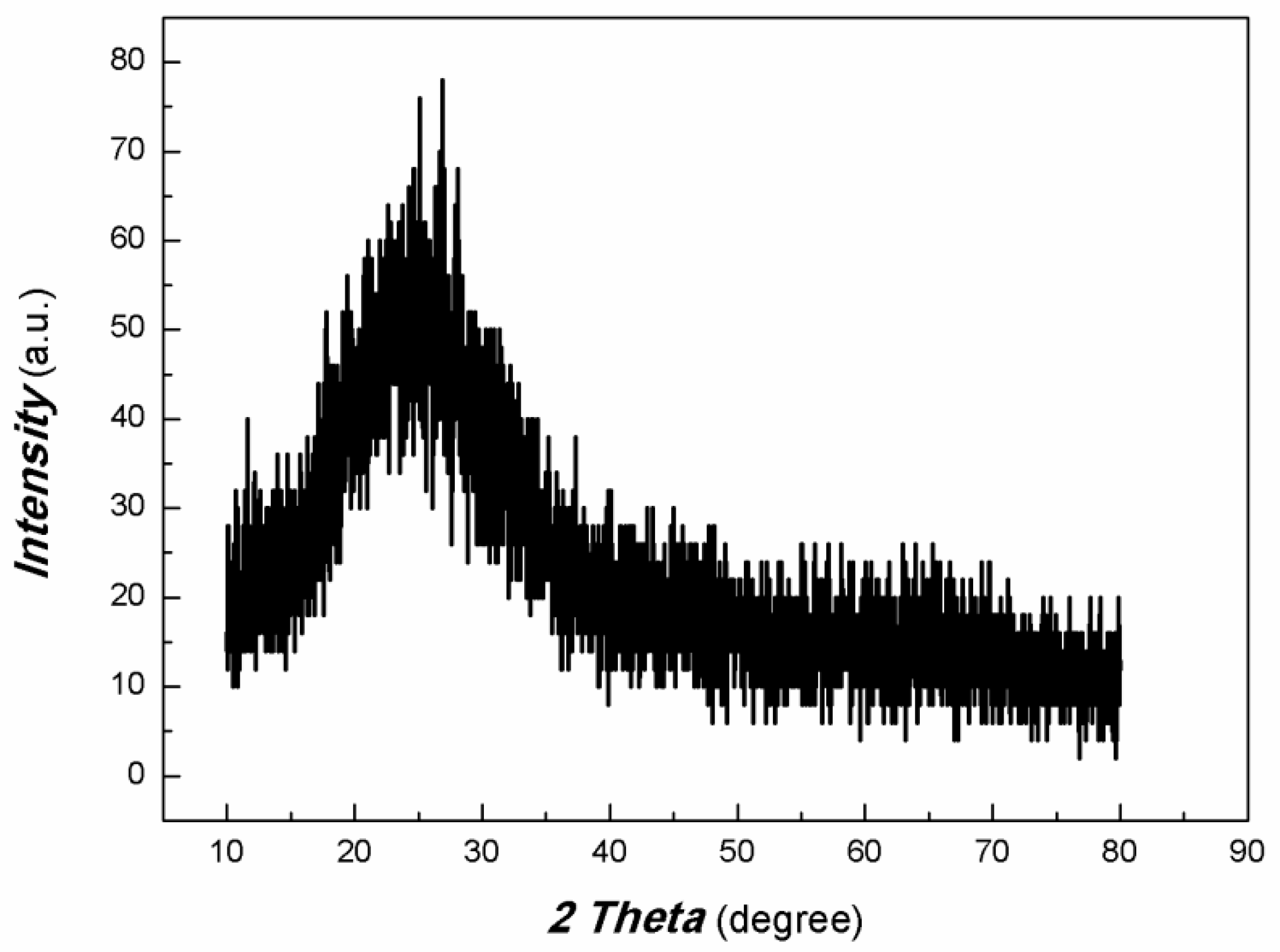
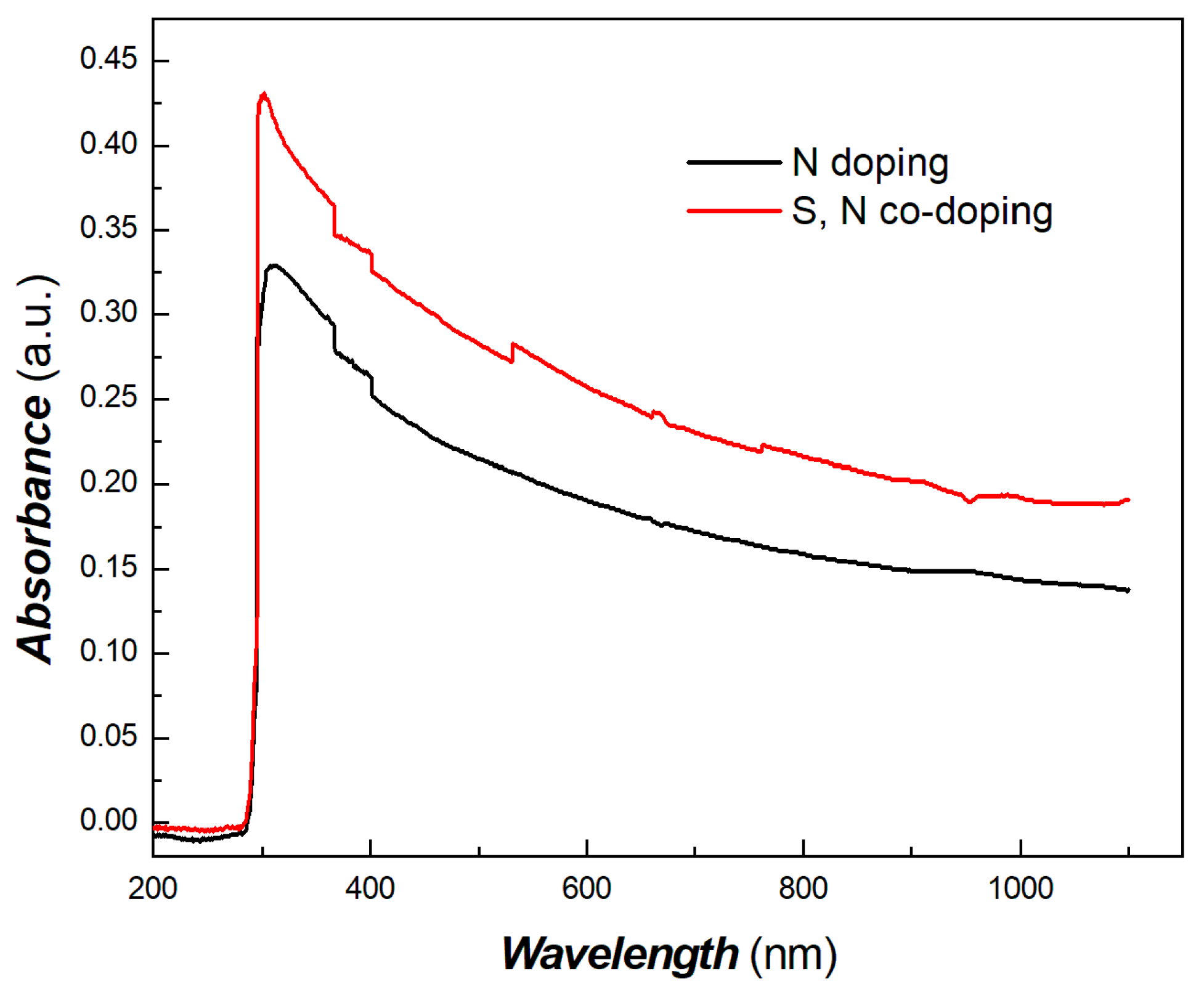
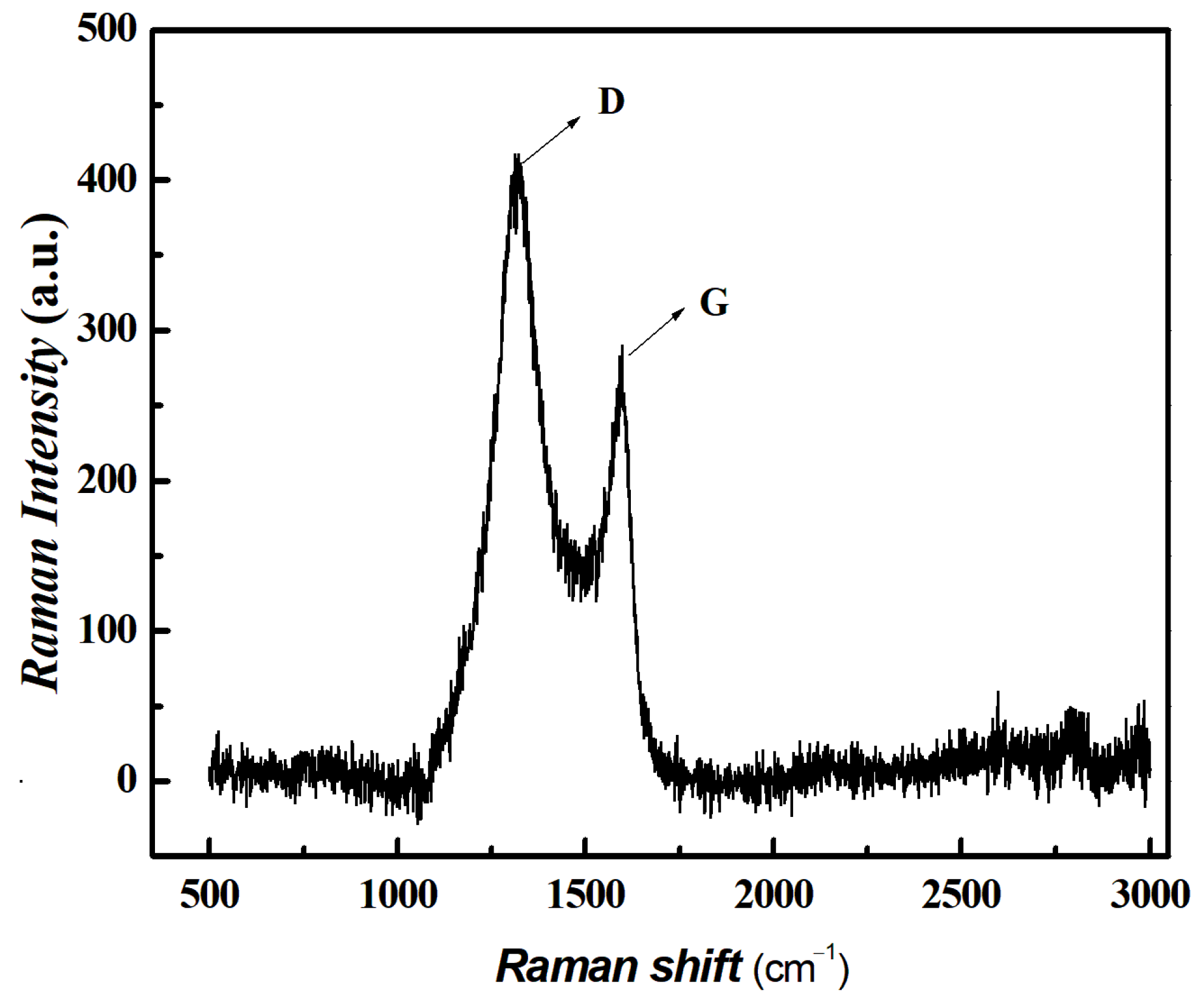
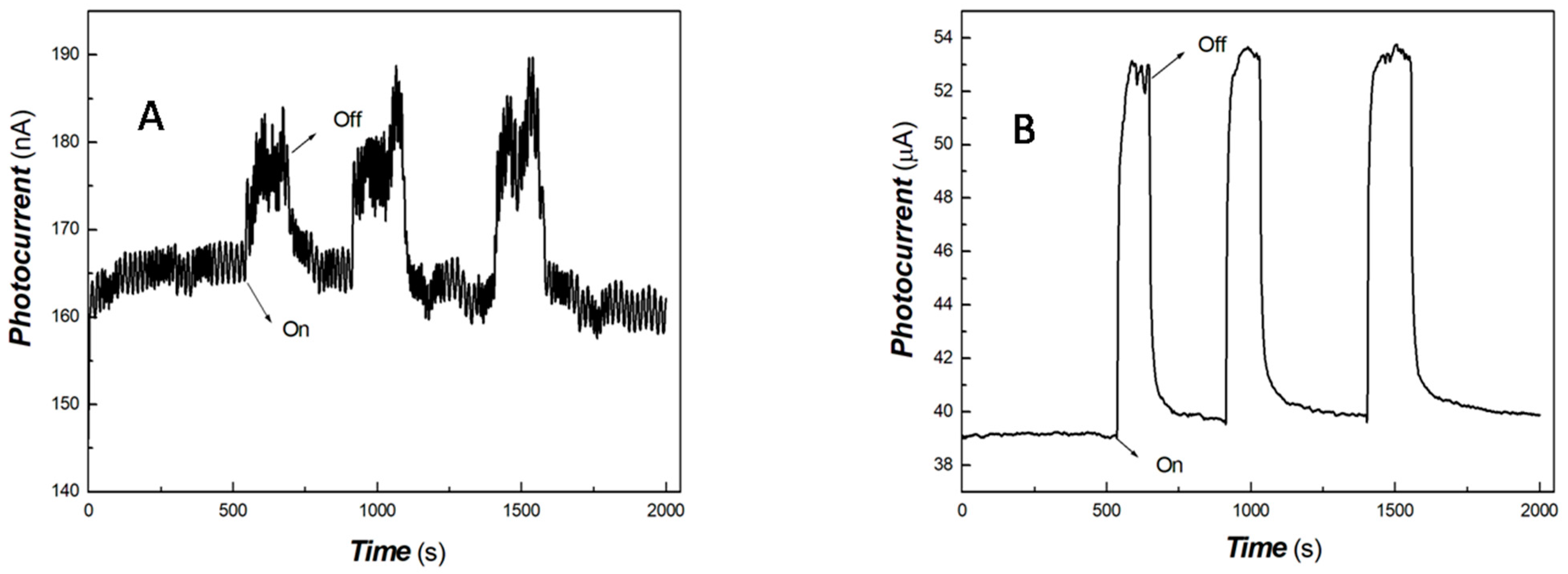
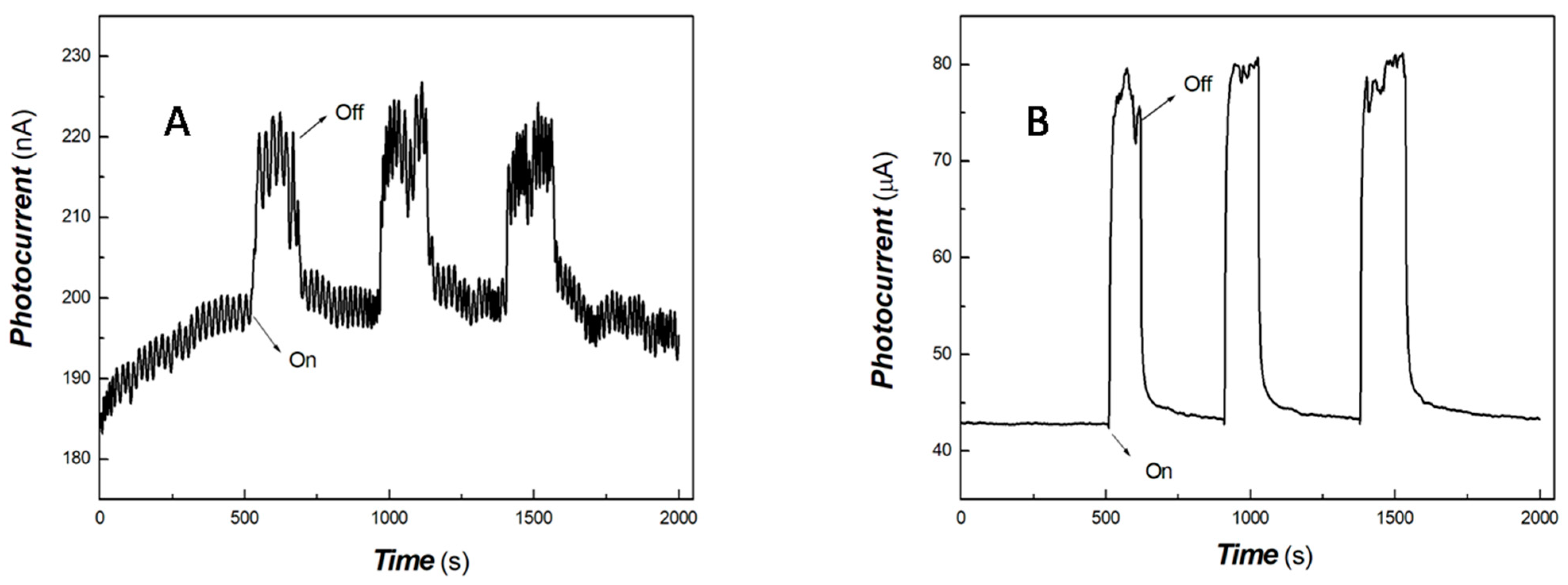
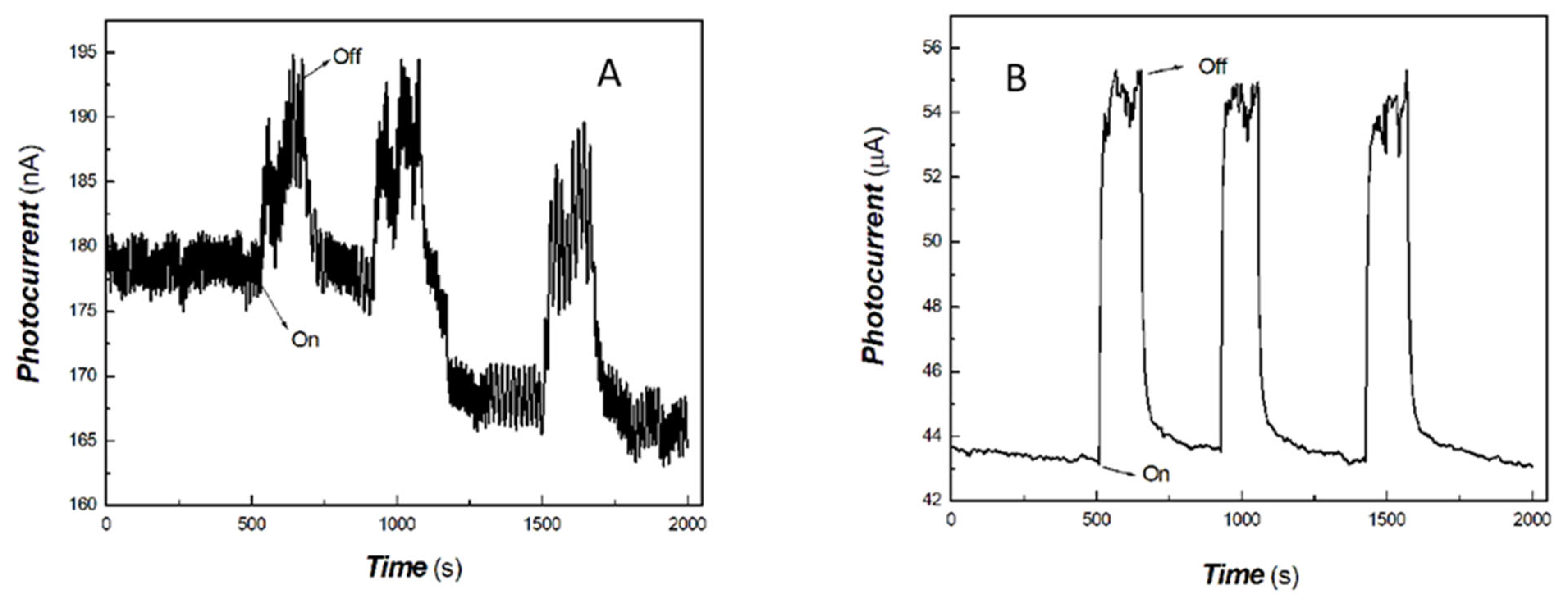
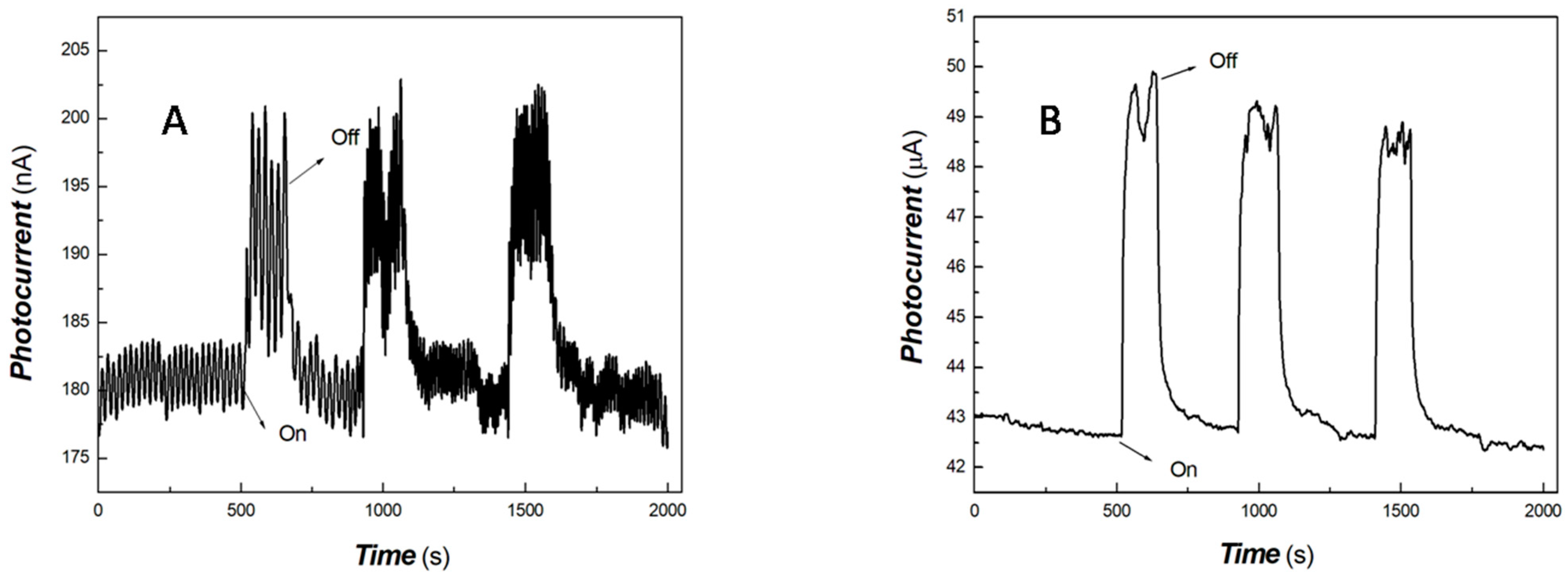
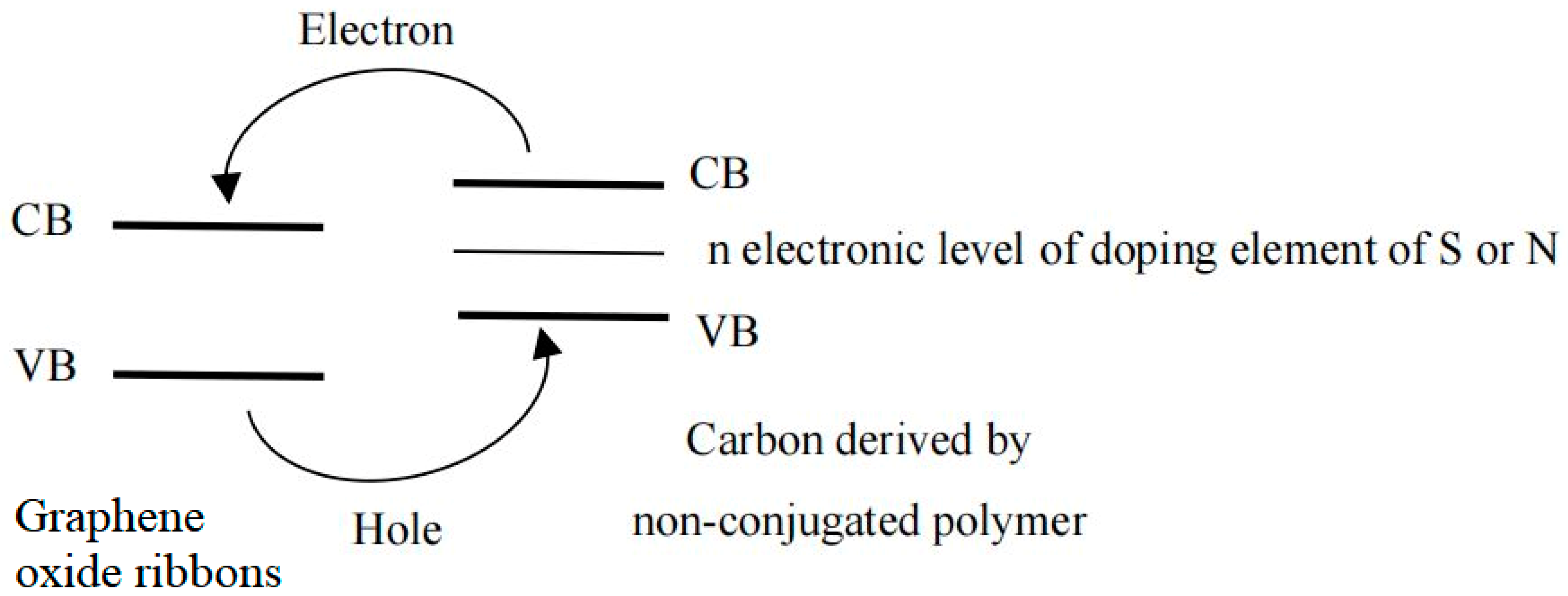

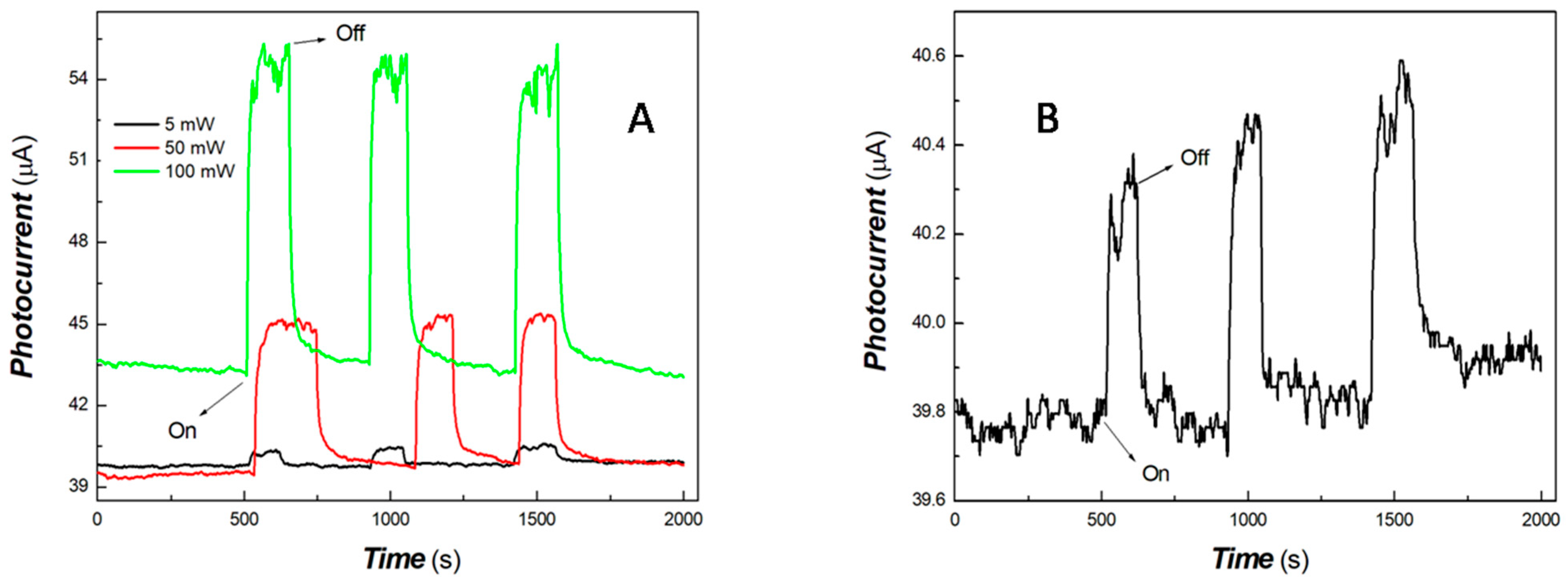


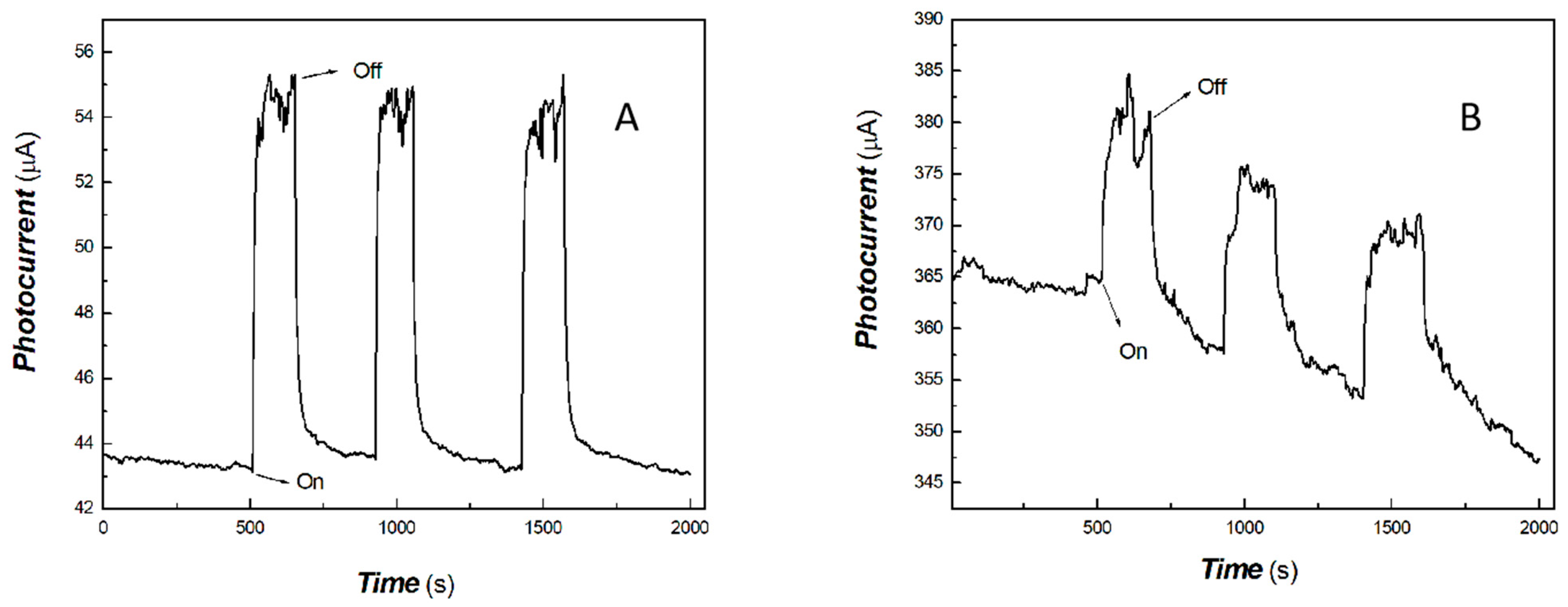

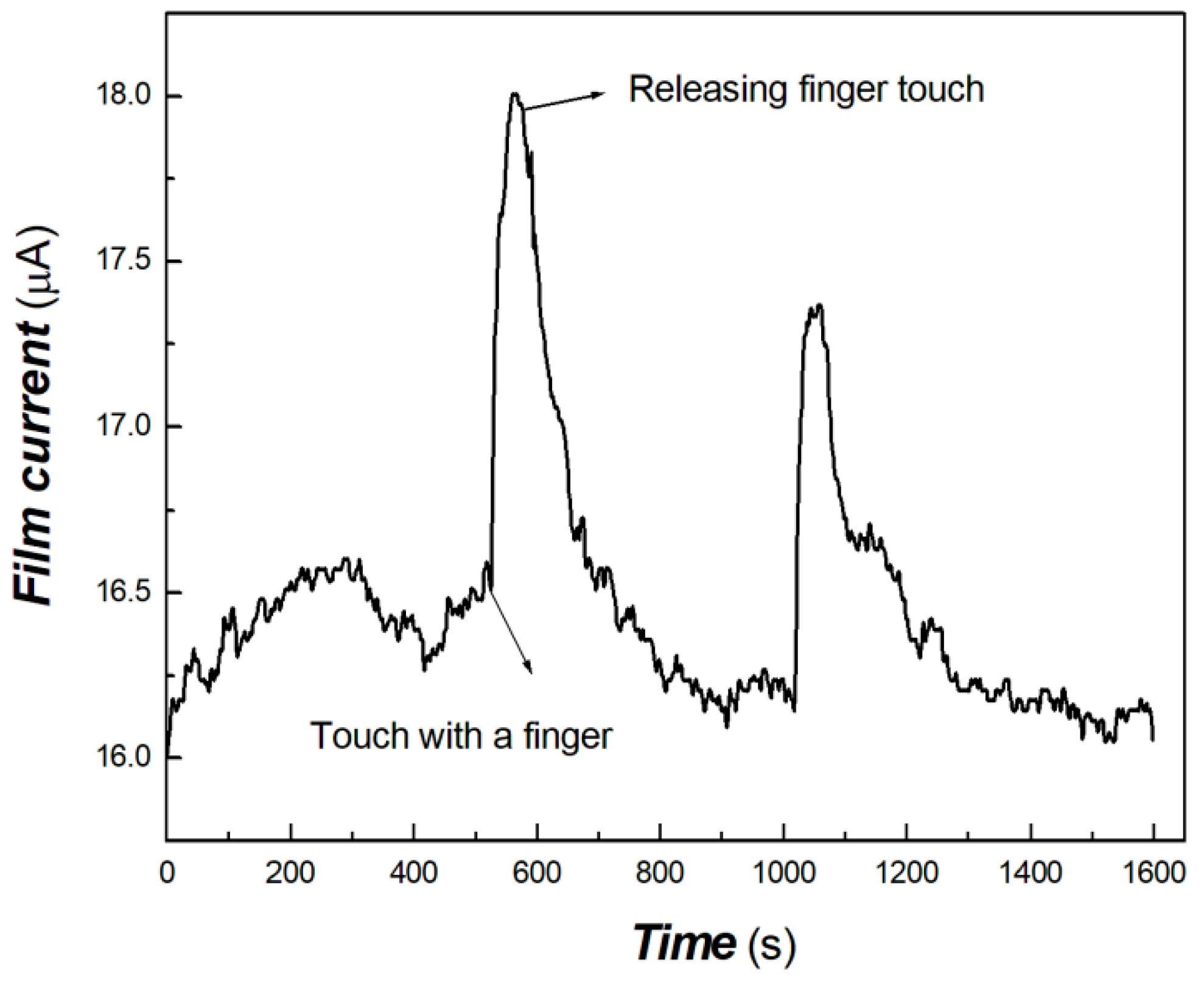


| Excitation Light Wavelength (nm) | Sample No. | Response Time (s) | Recovery Time (s) | Ratio of On/Off |
|---|---|---|---|---|
| 50 mW 650 nm | 1# S, N-co-doped low-dimensional C nanoribbons/C nanocomposites | 18.00 | 51.43 | 1.35 |
| 50 mW 650 nm | 2# N-co-doped low-dimensional C nanoribbons/C nanocomposites | 13.71 | 34.28 | 1.11 |
| 200 mW 808 nm | 1# S, N-co-doped low-dimensional C nanoribbons/C nanocomposites | 8.58 | 42.85 | 1.79 |
| 200 mW 808 nm | 2# N-co-doped low-dimensional C nanoribbons/C nanocomposites | 25.72 | 21.43 | 1.10 |
| 100 mW 980 nm | 1# S, N-co-doped low-dimensional C nanoribbons/C nanocomposites | 17.14 | 30.85 | 1.25 |
| 100 mW 980 nm | 2# N-co-doped low-dimensional C nanoribbons/C nanocomposites | 21.43 | 80.47 | 1.07 |
| 20 mW 1064 nm | 1# S, N-co-doped low-dimensional C nanoribbons/C nanocomposites | 22.28 | 51.43 | 1.15 |
| 20 mW 1064 nm | 2# N-co-doped low-dimensional C nanoribbons/C nanocomposites | 17.14 | 26.13 | 1.09 |
| Sample No. | Atomic Percent (%) | C Element | O Element | N Element | S Element | Other Elements |
| 1# S, N-co-doped low-dimensional C nanoribbons/C nanocomposites | 53.72 | 27.77 | 8.06 | 6.30 | Na: 0.34; Al: 0.14; Si: 0.46; Cl: 0.14; K: 0.59; Ca: 2.47 | |
| 2# N-co-doped low-dimensional C nanoribbons/C nanocomposites | 59.28 | 18.00 | 21.69 | 0.05 | Na: 0.07; Mg: 0.06; Al: 0.08; Si: 0.34; P: 0.05; Cl: 0.04; Ca: 0.34 | |
| Sample No. | Weight Percent (%) | C Element | O Element | N Element | S Element | Other Elements |
| 1# S, N-co-doped low-dimensional C nanoribbons/C nanocomposites | 41.46 | 28.55 | 7.25 | 12.98 | Na: 0.50; Al: 0.24; Si: 0.83; Cl: 0.33; K: 1.48; Ca: 6.37 | |
| 2# N-co-doped low-dimensional C nanoribbons/C nanocomposites | 53.27 | 21.54 | 22.73 | 0.11 | Na: 0.11; Mg: 0.11; Al: 0.19; Si: 0.72; P: 0.13; Cl: 0.09; Ca: 1.01 | |
 | 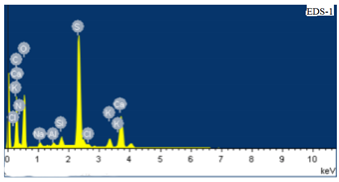 | |||||
| (a) | (b) | |||||
| 1#-S, N co-doped low-dimensional C/C nanocomposite | ||||||
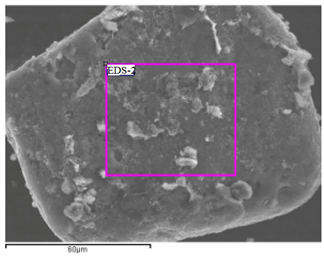 |  | |||||
| (a) | (b) | |||||
| 2#-N-doped low-dimensional C/C nanocomposite | ||||||
Disclaimer/Publisher’s Note: The statements, opinions and data contained in all publications are solely those of the individual author(s) and contributor(s) and not of MDPI and/or the editor(s). MDPI and/or the editor(s) disclaim responsibility for any injury to people or property resulting from any ideas, methods, instructions or products referred to in the content. |
© 2024 by the authors. Licensee MDPI, Basel, Switzerland. This article is an open access article distributed under the terms and conditions of the Creative Commons Attribution (CC BY) license (https://creativecommons.org/licenses/by/4.0/).
Share and Cite
Ma, X.; Zhang, X.; Gao, M.; Wang, Y.; Li, G. Green Preparation of S, N Co-Doped Low-Dimensional C Nanoribbon/C Dot Composites and Their Optoelectronic Response Properties in the Visible and NIR Regions. Materials 2024, 17, 4167. https://doi.org/10.3390/ma17174167
Ma X, Zhang X, Gao M, Wang Y, Li G. Green Preparation of S, N Co-Doped Low-Dimensional C Nanoribbon/C Dot Composites and Their Optoelectronic Response Properties in the Visible and NIR Regions. Materials. 2024; 17(17):4167. https://doi.org/10.3390/ma17174167
Chicago/Turabian StyleMa, Xingfa, Xintao Zhang, Mingjun Gao, You Wang, and Guang Li. 2024. "Green Preparation of S, N Co-Doped Low-Dimensional C Nanoribbon/C Dot Composites and Their Optoelectronic Response Properties in the Visible and NIR Regions" Materials 17, no. 17: 4167. https://doi.org/10.3390/ma17174167
APA StyleMa, X., Zhang, X., Gao, M., Wang, Y., & Li, G. (2024). Green Preparation of S, N Co-Doped Low-Dimensional C Nanoribbon/C Dot Composites and Their Optoelectronic Response Properties in the Visible and NIR Regions. Materials, 17(17), 4167. https://doi.org/10.3390/ma17174167




_Ma.jpg)



